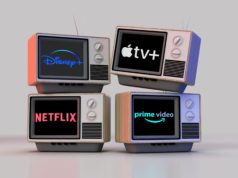 A few weeks ago, my son and I had one of those adventures that we will be talking about for years to come, launching a weather balloon and rig equipped with 3D cameras into the stratosphere and tracking its path through space and eventual landing in the Southern California desert.
A few weeks ago, my son and I had one of those adventures that we will be talking about for years to come, launching a weather balloon and rig equipped with 3D cameras into the stratosphere and tracking its path through space and eventual landing in the Southern California desert.
The project was the brainchild of and led by our good friend and neighbor, and digital media veteran, Josh Kline. I had the opportunity to sit down with Josh and have him describe the project and the significant role that technology and digital media played in the process. Here is our Q&A:
This was no easy process and time-consuming to say the least. What made you want to do this?
I’ve been a space junkie my whole life. I have a framed copy of the New York Times on my wall from the day Neil Armstrong walked on the moon, July 21, 1969. Space represents to me what is possible when we put our minds to accomplishing a difficult task. It’s rare that civilians get to experience things as majestic as a view of the earth from space (or near-space), or even have anything to do with capturing that imagery. I’d seen several videos and pictures shot from high altitude weather balloons over the past couple of years and thought they were awe-inspiring. Last year’s Citi Superbowl spot is a good example. I always thought it would be a fun project to do with my 7-year-old son. Then, a couple of Canadian high school kids sent a rig up with a little Lego man in front of the camera and it was such a simple, cool approach, and a great video (about 3 million YouTube viewers agree with that sentiment). That was really the trigger where I went from thinking “I could do that” to “I’m going to do that.” I had friends and their kids pitch in along the way, like my neighbors Jason and Gavin Post and Ned and Ted Sherman.
Now that we’ve provided the background, let’s show our readers the video:
Wow, that is really amazing to see the rig we launched ascending into the stratosphere and reaching that calm dark before the balloon pops. I know this isn’t the first project like this, but this one was unique. How is this project different from others who have done similar launches and why is this special?
Once I decided to do the project, I also decided I wanted it to be unique. Some projects have utilized video cameras, some still cameras, some shot video out and others down. Knowing there’s always a chance these rigs won’t be recovered, I wanted to make sure I captured as much footage as possible in as many formats as possible on my first attempt. I contacted a friend who works for Go Pro (the action sports camera company), David Newman, and told him what I was up to. After he discussed it with his CEO and marketing team, they agreed to lend me all of the cameras I would need for the rig and to capture footage on the ground. This ended up being by far the most camera-laden rig to date: 6 cameras total, including 2 in a 3D video configuration pointing outward, 2 in a 3D video configuration mounted beneath the rig and pointing upward, a 2D video camera aimed at the ground, and a camera set to take time lapse stills pointing outward.
As it turned out, the timing of this project was ideal in that Go Pro had just released their new 3D camera kits, and if I could get my project off the ground (literally) in time, I would be able to capture the first ever 3D video in the stratosphere and from a high altitude weather balloon. David helped me tremendously with the 3D setup. Shooting 3D would require the placement of an object between the cameras and the background, and since we were shooting in “space,” I opted for the spaceship from my favorite show from my childhood, the Argo from Star Blazers (aka Space Battleship Yamato). David told me after the fact that using the ship from Star Blazers was what actually got the Go Pro team excited enough to ship me thousands of dollars’ worth of gear. Goes to show…you never know what’s going to do the trick.
I actually started the editing process on my own, then came to the conclusion that my editing skills are middling on a good day. I really wanted the video to have a polished look as opposed to the typical UGC project, so I called a pal, Kyle Jackson who owns Tunnel Post, and he came to the rescue via his facility and one of his editors, Damian Drago. There’s no way I would have figured out how to do the 2D+3D quad launch shot or some of the other tricky ones in a reasonable amount of time.
Also unique about our project is that we decided to make it a fundraiser for my son’s school, Wonderland Elementary. It’s a public school and the community fills in so many holes in the budget through charitable donations, that it just seemed like a fun, creative way to raise money. Special thanks to Malik Ducard and Will Young at YouTube/Google for helping me set up the partner account so I could generate ad revenue via this project. I hope this serves as a something of a template for other fundraising videos to support public schools.
When did technology take on a major role in the project?
Almost from the word “go.” By virtue of using digital cameras, tech as a major component of the project was inevitable. Certainly when we introduced 3D to the mix things got more complicated and the assistance of the camera manufacturer sped things along. Where things got most complicated, however, was in plotting the rig’s course. Such launches in Southern California are a rarity. As it turns out, this is far from an ideal region for this kind of activity. The land is rugged, the air currents change frequently and there’s an ocean on one side. This really introduced a massive number of variables. Luckily, there are tools out there that allowed me to generate some good guesstimates as to where this rig would land. For instance, the University of Wyoming College of Engineering has what looks like a very simple web page which on the back end taps into real-time weather pattern data and kicks out a file that when imported into Google Earth presents a 3D estimate of the flight path. With weather patterns changing frequently, it required hundreds of iterations leading up to our launch to really nail down our launch and estimated landing sites.
To recover the rig – assuming it didn’t fail in some way – would require GPS assistance. There is satellite GPS and radio GPS. To play it safe, I opted for both. It’s a good thing I did because the radio GPS device didn’t function. SPOT GPS is a consumer product that made things relatively easy on that front. It’s worth mentioning that I pulled technology and materials together from a number of sources, but the parts for the rig itself and much assistance were provided by Ben Longmier, Ph.D. who runs a site to promote projects like this at www.projectaether.org.
What technologies did you utilize that were not available 10 years ago…10 months ago…10 weeks ago?
For starters, 3D cameras light and sturdy enough to launch 20 miles up and survive a rough landing, with memory cards fast enough to capture 1080P video. That’s the one thing that could not have been accomplished on a “hobby” weather balloon launch any sooner than ours. Thanks, Go Pro!
Other than that, the flight plan forecasting technology probably had the greatest impact. In other regions, these balloon flights may come down 10-20 miles from the launch site. We knew this rig would travel 60-90 miles over land, and without a decent way to estimate where that landing would be, this project would not have been feasible in Southern California. One of the people providing technical assistance told me that this project which cost around $2,000 plus the cameras would have cost $100,000 ten years ago. That’s mostly because the weather forecasting computing power was not available to civilians back then, nor was the 3D flight plan mapping that Google Earth does so easily now. Although not perfect, the GPS gear is certainly more consumer friendly at this point than earlier versions.
Once the video was shot, the new technologies that we utilized include Go Pro’s 3D rendering software. I expect we’ll all start seeing many more 3D videos because of what those guys are doing. Also, YouTube’s ability to play back video in a number of 3D formats is incredibly useful and has only been around for a couple of years. It works great for Mac/PC playback, but not yet supported on mobile devices.
What did you run into that was most unexpected?
If I knew then what I know now… There are strict limits as to how heavy these rigs can be so as to minimize the threat to aircraft and anything the rig may land on, and 3D cameras necessarily added more weight. We also had a pair of GPS devices to deal with. Luckily we built a carbon fiber frame so were able to keep things legal… but just barely.
Trickier yet was the remaining fusillade of regulations to which one must adhere in order to launch what’s referred to as a “high ball.” The list includes the FAA, local airport tower, SoCal TRACON, SoCal Flight Control, Edwards Air Force Base. I had to call them the day before the launch and a couple of times each the day of the launch. Makes sense when you consider what a bird can do to a jet engine, but it’s a lot to deal with.
The launch itself was quite nerve-racking. There’s a real sense of “what if this thing _____” and running through mental checklists. There’s so much equipment to deal with and making sure it’s all up and running. Ultimately, you just have to let go of the thing and hope you prepped properly. Our original launch site was a school in Sunland, about 30 minutes out of L.A., but it was locked up when we got there so we scrambled to find a new site. We ended up launching from La Cañada High School which is roughly next door to JPL. None of us knew if we needed to clear that, seeing as how JPL is a NASA facility. With no time to spare, we launched, and all stared up at the balloon wondering if a rocket from JPL was going to shoot our balloon out of the sky. Luckily, the launch went off swimmingly.
One thing I would do differently, however, would be to add a small blinking light to the rig. Seems like a small detail, but its inclusion would have saved 5 hours and hundreds of miles of driving. After the launch, which was attended by about a dozen people and many more onlookers, the next task was to collect the rig, which was going to land a couple hours away in Apple Valley. Because the weather had been poor that morning, and our need to change launch locales, we didn’t launch until about 2 p.m. This was standard time back in February so we knew we would run up against available daylight issues. While the saner among the group head back to L.A. and were tracking the rig via the SPOT GPS website, I hopped into a borrowed, monstrous 4×4 along with my son Cooper, Ned Sherman and his son Ted, and off we drove to Apple Valley. By the time we got near the GPS signal, the sun was nearly dropping behind the mountains and we only had an hour or so to locate the rig. It came down in the foothills, well beyond the realm of paved roads, and the four of us were doing our best to triangulate images from the SPOT GPS website on an iPad and Google Maps images from a laptop. Ultimately, it got too dark and where we were is no place to have a couple of little kids at night, so we hopped back in the truck and drove back to L.A. to catch the last bit of the Oscars. The next day was a Monday, and I made the 2-hour drive back out to the site alone. I’d spent some time reviewing the SPOT GPS and Google Maps images, and was committed to coming home with the rig.
When I parked the truck and hopped out, it hit me that unlike the mild evening before, it was now 40 degrees, with 50+ MPH winds and sleet. Off I went into the wilderness and after hiking about for 30 minutes, I retrieved the rig. I was confused as to why a couple of the cameras had popped off their mounts and were laying on the ground, but a review of the video later made that abundantly clear. Back to the truck, back to L.A., a smile on my face the whole time. That said…attaching a little blinking light would have enable us to find the rig the night before as soon as the sun set.
So what’s next?
This project was a blast for me, my son, and the rest of my friends and their kids who participated. I still have 2 more balloons, so am trying to figure out how to one-up the last launch. I hope you enjoy the video. It’s best if you can dig up a pair of anaglyph (red/blue) 3D glasses, but you can toggle the 3D off in the YouTube player.
Josh Kline is the GM of Online Services for Final Draft, the entertainment industry’s standard for screenwriting software. He previously co-founded Sample Digital, where he launched and patented Digital Dailies®, and subsequently founded Secure Path Technology, a metadata services company. He is also a producer hell-bent on bringing the classic Japanese anime series Star Blazers to life as a live-action feature film franchise. Josh lives in Los Angeles with his wife Ann and their son Cooper. After launching several cloud-based technology companies, he decided to aim higher and launch a balloon into the stratosphere.







